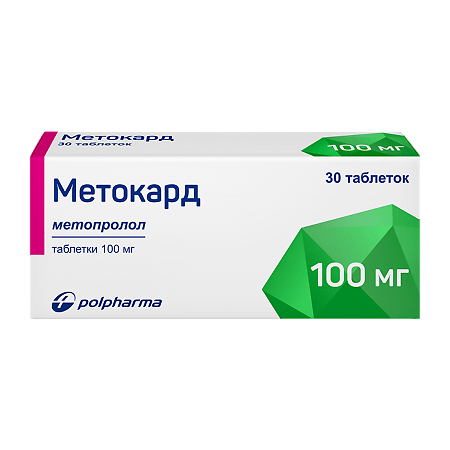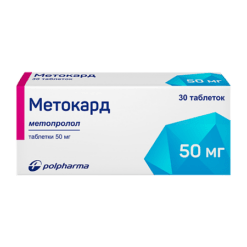No products in the cart.
Metocard, tablets 100 mg 30 pcs
€1.00
Out of stock
(E-mail when Stock is available)
Description
Methocard – antiarrhythmic, hypotensive, antianginal.
Selectively blocks beta1 adrenoreceptors, inhibits the action of endogenous catecholamines, inhibits the activity of the renin-angiotensin system.
Pharmacodynamics
Decreases minute volume and heart function. Inhibits central sympathetic impulses. Does not have membrane-stabilizing effects and has no intrinsic sympathomimetic activity.
Pharmacokinetics
It is rapidly and almost completely absorbed from the gastrointestinal tract. Cmax and Tmax with Metocard 100 mg or Metocard retard administration are 99.4±33 ng/mg and 1.58±0.55 h, or 152.9±72.8 ng/mL and 2.75±0.87 h. Protein binding is 11-12%. Metabolized in the liver, T1/2 – 3.5 h. It is excreted mainly by the kidneys (95%). Passes through the placenta.
Indications
Indications
Arterial hypertension, IBS, heart failure
Active ingredient
Active ingredient
Composition
Composition
1 tablet contains metoprolol tartrate 100 mg.
How to take, the dosage
How to take, the dosage
Metocard is taken orally, without chewing, with a small amount of liquid.
Arterial hypertension – 50 mg 2 times daily; if necessary, after a week, the dose is increased to 200 mg/day (2 tablets of 100 mg). If there is no positive therapeutic result, the drug may be used in combination with other antihypertensive or diuretic agents.
In angina pectoris, 50-100 mg 2-3 times daily; if necessary, the dose can be increased to 400 mg/day.
In heart rhythm disorders – 50 mg 2-3 times daily.
When treating elderly patients, caution should be exercised (generally no dose adjustment is required).
The maximum dose is 400 mg/day.
Interaction
Interaction
Combined use of Metocard with MAO inhibitors is not recommended due to a significant increase in the hypotensive effect. Treatment interval between MAO inhibitors and metoprolol should be at least 14 days.
Concomitant intravenous administration of verapamil may induce cardiac arrest.
The concomitant administration of nifedipine leads to a significant decrease in blood pressure.
The agents for inhaled general anesthesia (hydrocarbon derivatives) increase the risk of myocardial depression and arterial hypotension.
Beta-adrenergic stimulants, theophylline, cocaine, etrogens (sodium retention), indomethacin and other non-steroidal anti-inflammatory drugs (sodium retention and blocking of prostaglandin synthesis by the kidneys) weaken the hypotensive effect.
There is marked an increased suppressive effect on the central nervous system – with ethanol; summation of the cardiodepressant effect – with the means for general anesthesia; increased risk of peripheral circulatory disorders – with ergot alkaloids.
In co-administration of Metocard with hypoglycemic agents for oral administration, their effect may be reduced; with insulin – increased risk of hypoglycemia, its increased severity and prolongation, masking of some symptoms of hypoglycemia (tachycardia, sweating, increased arterial pressure).
When combining Metocard with hypotensive agents, diuretics, nitroglycerin or slow calcium channel blockers, a sharp decrease in blood pressure may develop (special caution is required when combined with prazosin); increased severity of heart rate depression and suppression of atrioventricular conduction – when using metoprolol with verapamil, diltiazem, antiarrhythmic agents (amiodarone), reserpine, alpha-metaldopa, clonidine, guanfacine, agents for general anesthesia and cardiac glycosides.
If metoprolol and clonidine are taken at the same time, then clonidine should be withdrawn after a few days if metoprolol is withdrawn (due to the risk of withdrawal).
Hepatic microsomal enzyme inducers (rifampicin, barbiturates) lead to increased metabolism of metoprolol and decreased plasma concentrations of metoprolol and reduced effect. Inhibitors (cimetidine, oral contraceptives, phenothiazines) – increase plasma concentrations.
Allergens used for immunotherapy or allergen extracts for skin tests when combined with metoprolol increase the risk of systemic allergic reactions or anaphylaxis; iodine containing x-ray contrast agents for IV administration increase the risk of anaphylactic reactions.
Decreases clearance of xanthine (except diphylline), especially with initially increased clearance of theophylline as a result of smoking. Reduces lidocaine clearance, increases plasma concentration of lidocaine.
Enhances and prolongs the effect of antidepolarizing myorelaxants; prolongs the anticoagulant effect of coumarins.
When used with ethanol the risk of significant BP decrease increases. Tri- and tetracyclic antidepressants, antipsychotic drugs (neuroleptics), sedatives and hypnotics increase CNS depression.
Special Instructions
Special Instructions
Management of patients taking beta-adrenoblockers includes regular monitoring of heart rate (HR) and blood pressure, blood glucose content in diabetic patients. If necessary, for diabetic patients, the dose of insulin or hypoglycemic agents administered orally should be adjusted individually.
The patient should be instructed on how to calculate heart rate and instructed to consult a physician if the heart rate is less than 50 bpm. Dose higher than 200 mg per day decreases cardioselectivity.
In patients with heart failure, treatment with metoprololol should not be started until the compensatory phase has been reached.
There may be an increase in hypersensitivity reactions (with a history of allergic reactions) and no effect of the usual doses of epinephrine (adrenaline).
It may aggravate the symptoms of peripheral arterial circulatory disorders. The drug should be withdrawn gradually, reducing the dose over 10 days.
The withdrawal syndrome (increased angina attacks, increased blood pressure) may occur if treatment is stopped abruptly.
Particular attention should be paid to patients with angina pectoris when withdrawing the drug.
In patients with angina pectoris, the selected dose of the drug should provide a resting heart rate of 55-60 bpm, and a maximum of 110 bpm on exertion.
Patients who wear contact lenses should be aware that treatment with beta-adrenoblockers may decrease tear fluid production.
Methoprolol may mask some clinical manifestations of hyperthyroidism (e.g., tachycardia). Abrupt withdrawal in patients with thyrotoxicosis is contraindicated because it may exacerbate the symptoms.
In diabetic patients may mask tachycardia caused by hypoglycemia. Unlike non-selective beta-adrenoblockers, it practically does not increase insulin-induced hypoglycemia and does not delay the recovery of blood glucose concentration to normal levels.
In patients with bronchial asthma, beta-2-adrenoceptors are used as concomitant therapy; in pheochromocytoma, alpha-adrenoblockers are used.
If it is necessary to perform surgery, the anesthesiologist must be warned about the therapy (choice of general anesthesia agent with minimal negative inotropic effect), cancellation of the drug is not recommended.
Drugs that decrease catecholamine stores (e.g., reserpine) may increase the effects of beta-adrenoblockers, so patients taking these combinations of drugs should be under constant medical monitoring for excessive decreases in blood pressure and bradycardia.
In elderly patients, regular monitoring of liver function is recommended. The dosage regimen correction is required only in elderly patients with increasing bradycardia (less than 50 bpm), marked BP lowering (systolic blood pressure
Contraindications
Contraindications
Side effects
Side effects
Nervous system and sensory organs: headache, dizziness, nightmares, insomnia, depression, short-term amnesia, disorientation, paresthesia; visual disturbances, dry eyes, tinnitus.
Cardiovascular system and blood (hematopoiesis, hemostasis): bradycardia, palpitations, hypotension, AV conduction disorders, circulatory failure, thrombocytopenia, agranulocytosis.
Respiratory system: bronchospasm, choking.
Gastrointestinal system disorders: dry mouth, heartburn, flatulence, stomach pain, vomiting, constipation/diarrhea.
Allergic reactions: itching, rash, psoriatic skin changes.
Others: Peyronie’s disease, myalgia, alopecia.
Overdose
Overdose
Symptoms: severe sinus bradycardia, dizziness, nausea, vomiting, cyanosis, marked decrease in blood pressure, arrhythmia, ventricular ecstastole, bronchospasm, syncope, in acute overdose – cardiogenic shock, loss of consciousness, coma, atrioventricular block (up to development of complete transverse block and cardiac arrest), cardialgia.
The first signs of overdose appear 20 minutes to 2 hours after taking the drug.
Treatment: gastric lavage, prescription of adsorptive agents, symptomatic therapy: in case of marked decrease in arterial pressure the patient should be in Trendelenburg position; in case of excessive decrease in arterial pressure, bradycardia and heart failure – IV fluids with 2-5 min intervals, beta-adrenostimulants – until the desired effect is achieved, or IV 0.5 – 2 mg atropine sulfate.
In the absence of a positive effect – dopamine, dobutamine or norepinephrine (noradrenaline).
As a follow-up, it is possible to prescribe 1 – 10 mg of glucagon, placement of transvenous intracardiac pacemaker.
For bronchospasm, IV beta-2-adrenoreceptor stimulants should be administered.
Metoprolol is poorly excreted by hemodialysis.
Similarities
Similarities
Additional information
| Shelf life | 3 years |
|---|---|
| Conditions of storage | In a place protected from light, at a temperature not exceeding 25°C. |
| Manufacturer | Polpharma S.A., Poland |
| Medication form | pills |
| Brand | Polpharma S.A. |
Other forms…
Related products
Buy Metocard, tablets 100 mg 30 pcs with delivery to USA, UK, Europe and over 120 other countries.














